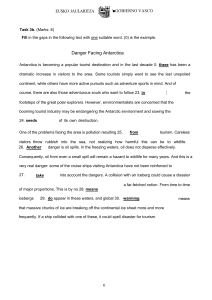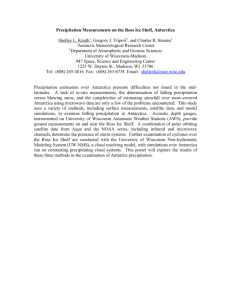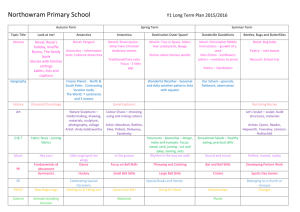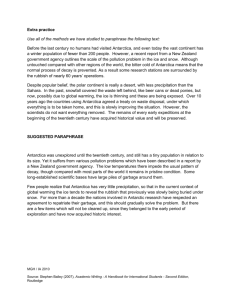16_uaj3_Interpopulation Deschampsia
advertisement
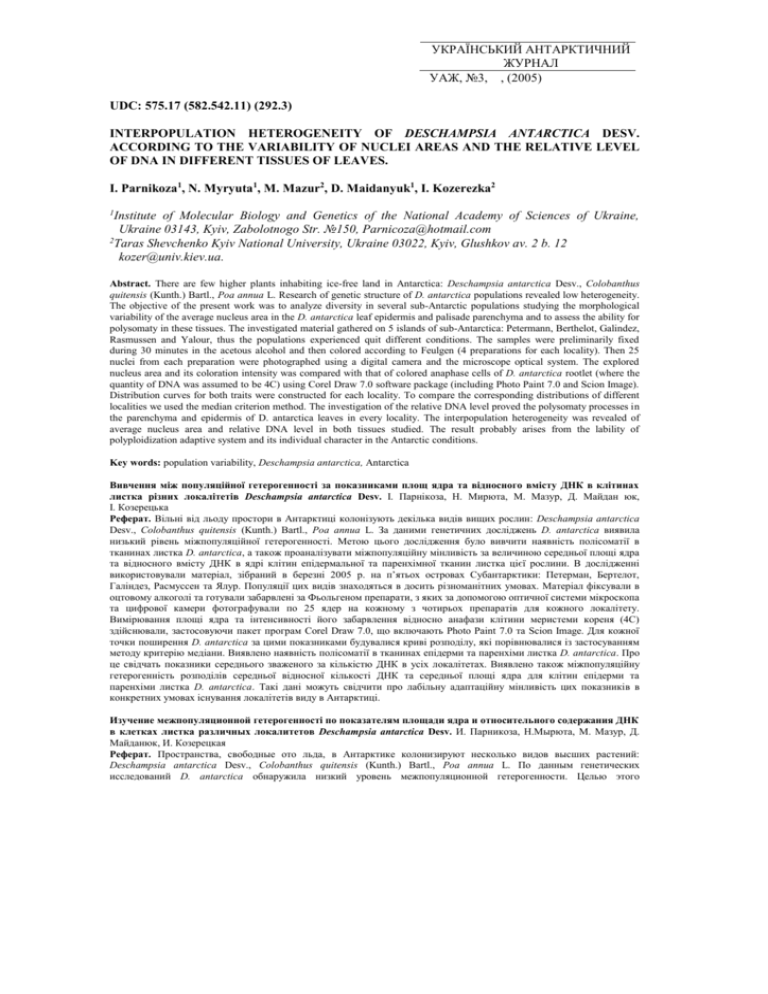
УКРАЇНСЬКИЙ АНТАРКТИЧНИЙ ЖУРНАЛ УАЖ, №3, , (2005) UDC: 575.17 (582.542.11) (292.3) INTERPOPULATION HETEROGENEITY OF DESCHAMPSIA ANTARCTICA DESV. ACCORDING TO THE VARIABILITY OF NUCLEI AREAS AND THE RELATIVE LEVEL OF DNA IN DIFFERENT TISSUES OF LEAVES. I. Parnikoza1, N. Myryuta1, M. Mazur2, D. Maidanyuk1, I. Kozerezka2 1 Institute of Molecular Biology and Genetics of the National Academy of Sciences of Ukraine, Ukraine 03143, Kyiv, Zabolotnogo Str. №150, Parnicoza@hotmail.com 2 Taras Shevchenko Kyiv National University, Ukraine 03022, Kyiv, Glushkov av. 2 b. 12 kozer@univ.kiev.ua. Abstract. There are few higher plants inhabiting ice-free land in Antarctica: Deschampsia antarctica Desv., Colobanthus quitensis (Kunth.) Bartl., Poa annua L. Research of genetic structure of D. antarctica populations revealed low heterogeneity. The objective of the present work was to analyze diversity in several sub-Antarctic populations studying the morphological variability of the average nucleus area in the D. antarctica leaf epidermis and palisade parenchyma and to assess the ability for polysomaty in these tissues. The investigated material gathered on 5 islands of sub-Antarctica: Petermann, Berthelot, Galindez, Rasmussen and Yalour, thus the populations experienced quit different conditions. The samples were preliminarily fixed during 30 minutes in the acetous alcohol and then colored according to Feulgen (4 preparations for each locality). Then 25 nuclei from each preparation were photographed using a digital camera and the microscope optical system. The explored nucleus area and its coloration intensity was compared with that of colored anaphase cells of D. antarctica rootlet (where the quantity of DNA was assumed to be 4С) using Corel Draw 7.0 software package (including Photo Paint 7.0 and Scion Image). Distribution curves for both traits were constructed for each locality. To compare the corresponding distributions of different localities we used the median criterion method. The investigation of the relative DNA level proved the polysomaty processes in the parenchyma and epidermis of D. antarctica leaves in every locality. The interpopulation heterogeneity was revealed of average nucleus area and relative DNA level in both tissues studied. The result probably arises from the lability of polyploidization adaptive system and its individual character in the Antarctic conditions. Key words: population variability, Deschampsia antarctica, Antarctica Вивчення між популяційної гетерогенності за показниками площ ядра та відносного вмісту ДНК в клітинах листка різних локалітетів Deschampsia antarctica Desv. І. Парнікоза, Н. Мирюта, М. Мазур, Д. Майдан юк, І. Козерецька Реферат. Вільні від льоду простори в Антарктиці колонізують декілька видів вищих рослин: Deschampsia antarctica Desv., Colobanthus quitensis (Kunth.) Bartl., Poa annua L. За даними генетичних досліджень D. antarctica виявила низький рівень міжпопуляційної гетерогенності. Метою цього дослідження було вивчити наявність полісоматії в тканинах листка D. antarctica, а також проаналізувати міжпопуляційну мінливість за величиною середньої площі ядра та відносного вмісту ДНК в ядрі клітин епідермальної та паренхімної тканин листка цієї рослини. В дослідженні використовували матеріал, зібраний в березні 2005 р. на п’ятьох островах Субантарктики: Петерман, Бертелот, Галіндез, Расмуссен та Ялур. Популяції цих видів знаходяться в досить різноманітних умовах. Матеріал фіксували в оцтовому алкоголі та готували забарвлені за Фьольгеном препарати, з яких за допомогою оптичної системи мікроскопа та цифрової камери фотографували по 25 ядер на кожному з чотирьох препаратів для кожного локалітету. Вимірювання площі ядра та інтенсивності його забарвлення відносно анафази клітини меристеми кореня (4С) здійснювали, застосовуючи пакет програм Corel Draw 7.0, що включають Photo Paint 7.0 та Scion Image. Для кожної точки поширення D. antarctica за цими показниками будувалися криві розподілу, які порівнювалися із застосуванням методу критерію медіани. Виявлено наявність полісоматії в тканинах епідерми та паренхіми листка D. antarctica. Про це свідчать показники середнього зваженого за кількістю ДНК в усіх локалітетах. Виявлено також міжпопуляційну гетерогенність розподілів середньої відносної кількості ДНК та середньої площі ядра для клітин епідерми та паренхіми листка D. antarctica. Такі дані можуть свідчити про лабільну адаптаційну мінливість цих показників в конкретних умовах існування локалітетів виду в Антарктиці. Изучение межпопуляционной гетерогенності по показателям площади ядра и относительного содержания ДНК в клетках листка различных локалитетов Deschampsia antarctica Desv. И. Парникоза, Н.Мырюта, М. Мазур, Д. Майданюк, И. Козерецкая Реферат. Пространства, свободные ото льда, в Антарктике колонизируют несколько видов высших растений: Deschampsia antarctica Desv., Colobanthus quitensis (Kunth.) Bartl., Poa annua L. По данным генетических исследований D. antarctica обнаружила низкий уровень межпопуляционной гетерогенности. Целью этого I. Parnikoza et al.: INTERPOPULATION HETEROGENEITY OF DESCHAMPSIA ANTARCTICA DESV. … исследования было изучение наличия полисоматии в тканях листа D. antarctica, а также анализ межпопуляционной изменчивости по величине средней площади ядра и относительного содержания ДНК в ядрах клеток эпидермальной и паренхимной тканей листка D. antarctica. В исследовании использовали материал, собранный в марте 2005 г. на пяти островах Субантарктики: Петерман, Бертелот, Галиндез, Расмуссен и Ялур. Популяции этих видов произрастали в достаточно разнообразных условиях. Материал фиксировали в уксусном спирте и готовили окрашенные по Фёльгену препараты, с которых с помощью оптической системы микроскопа и цифровой камеры фотографировали по 25 ядер на четырех препаратах с каждого локалитета. Измерение площади ядра и интенсивности его окрашивания относительно анафазы клетки меристемы корня (4С) проводили применяя пакет программ Corel Draw 7.0, который включает Photo Paint 7.0 та Scion Image. Для каждой точки распространения D. antarctica по этим показателям строились кривые распределения, которые сравнивались с применением метода критерия медианы. Выявлено наличие полисоматии в тканях эпидермы и паренхимы листка D. antarctica, о чем свидетельствуют показатели среднего взвешенного по количеству ДНК во всех локалитетах. Выявлено также межпопуляционную гетерогенность распределений среднего по относительному количеству ДНК и площади ядра клеток эпидермы и паренхимы листка D. antarctica. Такие данные могут свидетельствовать о лабильной адаптационной изменчивости этих показателей в конкретных условиях существования локалитетов вида в Антарктике. 1. Introduction On the Antarctic Peninsula shore and adjacent islands the temperature of the air in summer is on average above zero, and sometimes mounts to 300С (Lewis Smith, 2003). So the land is no longer ice-covered at summer, whereas the temperature is low during all other periods. In addition to the continent’s remoteness it causes low diversity f the Antarctic flora in comparison with Arctic floras: The Antarctic flora is represented mostly by lichens and mosses, and just a few species vascular plants (Deschampsia antarctica Desv., Colobanthus quitensis (Kunth) Bartl., Poa annua L) (Smith, 1996; Lewis Smith, 2003). Research of the plants adaptation mechanisms in the extreme habitats is thus of special significance (Alberdi, 2002). The morphological features of Deschampsia antarctica are those of a typical drought-resistant plant (Lewis Smith, 2003). Thus, stomata and thick cuticle being only at the upper side of the leaf, transpiration decreases. Investigation of the leaf anatomy did not show any specific genotype adaptations (Romer, 1999). The objective of the present work was to analyze the diversity in several sub-Antarctic populations of studying the variability of the average nucleus area in the D. antarctica leaf epidermis and palisade parenchyma. The characteristic was chosen as the one accurately reflecting cytological changes in nucleus functional activity. At the same time, research on the genetic structure of D. antarctica populations revealed their low genetica diversity (Holderegger, 2003), and the structures of 2 morphologically different King George island populations turned out to be similar (Chwedorzewska, 2004). We suggest this to be a result of prevailing autogamy and clon propagation, though the data are not sufficient for estimating the species propagation in whole. Therefore, we used as the criterion of interpopulation heterogeneity the functionally significant relative level of DNA, which is known to vary in different tissues varies with functional exertion. Polyploidy is peculiar to active cells (so-called polysomaties, Кinah, 1994). The second aim of the research was to ascertain the ability to polyploidyzation in the D. antarctica leaf tissues and to compare average relative DNA levels in individuals from different localities. 2. Materials, techniques and methods of data handling The investigated material was collected during the 10th Ukrainian Antarcic expedition and put at our disposal by V. Polischuk, who gathered plants 28-30 March 2005 at 5 localities of subAntarctica (Fig.1): 1. Petermann Island, (S 65о10/453//, W 64о08/452//), eminence, the middle of a steep slope of eastern exposition (20-40о), continuous strip (0,15m x 1m); no generative or dying plants were found in rocky clefts; 2. Berthelot Island (S 65о19/731//, W 64о08/613//) steep slope of western exposition (20-40о), cenosis cover 50%: mosses – 30%, D. аntarctica. – 20% (60% generative, 30% dying); I. Parnikoza et al.: INTERPOPULATION HETEROGENEITY OF DESCHAMPSIA ANTARCTICA DESV. … 3. Galindez Island (S 65о14/783//, W 64о14/799//) at the top of a height, declivous slope of eastern exposition (10о), cenosis cover 25%: mosses – 10%, D. аntarctica. – 15% (10% generative, 50% dying); 4. Rasmussen Cape (S 65о14/819//, W 64о05/156//), flat slope of western exposition (20о), cenosis cover 40%: mosses – 30%, D. аntarctica. – 10% (20% generative, 40% dying); 5. Yalour Island (S 65о14/139//, W 64о09/330//), on the crest of an eminence, flat slope of western exposition (20о), cenosis cover 45%, mosses – 25%, D. аntarctica. – 20% - 40% generative, 20% dying. Fig.1. Map of localities of Deschampsia antarctica sampled for our investigation. The interphase parenchyma and epidermis of the leaves in which we studied the average nucleus area and relative DNA level were preliminarily fixed during 30 minutes in acetous alcohol (3:1) and then colored according to Feulgen (Histological., 1994). Both parameters for each of the 5 localities were estimated on 4 preparations (25 photographs of nuclei per one preparation, Figs. 2, 3). Fig. 2. Epidermis cells of Deschampsia antarctica leaf, 3rd locality, 25х12,5. Fig. 3. Parenchyma cells of Deschampsia antarctica leaf, 3rd locality, 25х12,5. The analysis was performed using a digital camera CCD SAC-410 PA, AT Pentium-II personal computer with monitor, Asus V 3000 videodriver and Corel Draw 7.0 software package (including Photo Paint 7.0 and Scion Image). The green color filter of the microscope optical system and the red one Pal-n Asus V 3000 were applied. The areas of nuclei were measured using the operation “allocation of analyzed picture contour”. The values obtained were then transferred from pixels to μm2 I. Parnikoza et al.: INTERPOPULATION HETEROGENEITY OF DESCHAMPSIA ANTARCTICA DESV. … with later transferring the experimental data from pixels to the SI system using empirical conversion factors. To determine the relative DNA level we compared coloration intensity in the studied nucleus with that of a colored anaphase cell of the D. antarctica rootlet (where the quantity of DNA being assumed to be 4С). Distribution curves for both traits were constructed for each locality. To compare the corresponding distributions of different localities we used the median criterion method (Pollard, 1982). 3. Results and analysis Distribution curves for all characteristics studied in 5 localities of D. antarctica (Figs 4-7) are visibly asymmetrical. 1 45 60 40 2 35 3 50 30 4 40 25 5 30 20 20 15 10 10 5 0 0 -5 0 5 10 15 Fig. 4. Distribution curves of classes* of the nucleus area in epidermis of D. antarctica leaf (y-coordinate is frequency, x-coordinate is the number of the class). -10 5 10 15 Fig. 5. Distribution curves of classes* of relative DNA level in epidermis of D. antarctica leaf (ycoordinate is frequency, x-coordinate is the number of the class). 60 60 50 50 40 40 30 30 20 20 10 10 0 0 -10 0 0 5 10 15 Fig. 6. Distribution curves of classes* of the nucleus area in the parenchyma of D. antarctica leaf (y-coordinate is the frequency, x-coordinate is the number of the class). -10 0 5 10 15 Fig. 7. Distribution curves of classes* per relative DNA level in the parenchyma of D. antarctica leaf (y-coordinate is the frequency, x-coordinate is the number of the class). *The ranges for each class are presented in Table 2. Table 1. The average nucleus area and relative DNA level in epidermis and parenchyma of leaves of D. antarctica. I. Parnikoza et al.: INTERPOPULATION HETEROGENEITY OF DESCHAMPSIA ANTARCTICA DESV. … Epidermis Nucleous area, Relative DNA μm2 level, C 36.16.0 4.682.1 59.57.7 6.482.5 46.26.7 4.722.1 65.48.0 6.842.6 70.28.3 6.822.6 Locality 1 2 3 4 5 Table 2. The ranges for the classes of the examined traits of D. Antarctica. Class № 1. 2. 3. 4. 5. 6. 7. 8. 9. 10. 11. Nucleous area, μm2 < 20 20-29 30-39 40-49 50-59 60-69 70-79 80-89 90-99 100-109 >/=110 Relative DNA level, С < 0.99 1.00-2.99 3.00-4.99 5.00-6.99 7.00-8.99 9.00-10.99 11.00-12.99 13.00-14.99 15.00-16.99 17.00-18.99 >/=19.00 Table 3.The 2-criterion for pairwise comparison of distributions of average nucleolus area in epidermis for different localities of D. antarctica. 1 2 3 4 2 67.98 3 15.68 33.52 4 76.64 44.22 2 22.14 3 We confronted the distribution curves of different classes of nuclei areas for different localities and found statistically reliable distinctions between them by the median criterion. Tables 3-6 represent the 2-criterion for pairwise comparisons of the distributions. Only the 2 values that exceeded 3.84 are presented in the tables. Thus, the values measure the level of discrepancy between the localities (α=5%). Tables 3 and 4 show that the nucleus area distributions are distinctly dissimilar. It has been found that most of island localities essentially differ from other ones by the nucleus area criterion for both tissues. On the whole, the characteristic varies noticeably. Table 4. The 2-criterion for pairwise comparison of distributions of average nucleous area in the parenchyma for different localities of D. antarctica. 5 109.7 10.46 58.78 Table 5. The 2-criterion for pairwise comparison of distributions of average relative DNA level in epidermis of D. antarctica from different localities. 1 2 3 4 Parenchyma Nucleous area, μm2 Relative DNA level, C 38.56.2 5.412.3 36.86.0 5.962.4 28.35.3 6.642.5 31.75.6 7.102.6 24.64.9 6.162.4 4 23.4 5 31.46 25.4 33.68 24.1 2 1 2 3 4 3 13.54 4 11.06 5 28 48.08 3.48 12.5 Table 6. The 2-criterion for pairwise comparison of distributions of average relative DNA level in parenchyma of D. antarctica from different localities. 7 1 2 3 4 2 3 9.52 9.52 4 10.4 10.4 5 4.32 4.32 The pattern revealed might well originate from the adaptive flexibility of the nucleus area, which is known to be closely correlated with the DNA quantity. Thereby, one should expect similar heterogeneity patterns in the average relative DNA levels I. Parnikoza et al.: INTERPOPULATION HETEROGENEITY OF DESCHAMPSIA ANTARCTICA DESV. … in both parenchyma and epidermis. The result of the corresponding distributions comparison is given in Tables 5 and 6. Most of island localities essentially differ from other ones by the epidermal relative DNA level criterion for both tissues. The data obtained may well corroborate the adaptive polyploidization hypothesis and the individual character of adaptation under specific conditions of vegetation, which varied widely on different islands. The polysomaty in parenchyma and epidermis was clearly shown (Table 1). It may well be an adaptive mechanism under the conditions of Antarctica. 4. Conclusions 1. The research proved the polysomaty processes in parenchyma and epidermis of leaves of D. antarctica. 2. The revealed interpopulational heterogeneity of characteristics in the studied localities probably has arisen from the flexibility of the polyploidization adaptive system and its individual character in each case. Acknowledgments We are grateful to Prof. V. Polischuk (Department of Virology, Kyiv University), Prof. G. Milinevsky (National Ukrainian Antarctic Science Center), V. Adonin (Institute of Molecular Biology and Genetics of the National Academy of Sciences of Ukraine), V. Kunakh (Institute of Molecular Biology and Genetics of the National Academy of Sciences of Ukraine) for providing assistance in collecting the material, consultations and permits to use equipment. References Kunah V.A. Genomic variability of plant’s body cells. 1. Variability in ontogenesis. // Biopolimery i kletka. - 1994. - V. 10, N 6. - P. 5-35. Pollard J. Handbook on statistical calculation methods. - М.: Finansy i statistika, 1982. - 344 pp. Alberdi M., Bravo L. A., Gutierrez A., et al. Ecophysilogy of Antarctic vascular plants. // Physiol. Plant. - 2002. - 115. – Р. 479-486. Chwedorzewska K. J., Bednarek P. T., Puchalski J. Molecular variations of antarctic grass Deschampsia antarctica Desv. from King George Island (Antarctica) // Acta Societatis Botanicorum Poloniae. - 2004. - 73. - 1. - Р. 23-29. Kiernan J. A. (ed.) Histological & Histochemical Methods: Theory and Practice. Ed. 2. Oxford: Pergamon Press., 1990. - P. 136-364. Holderegger R., Stehlik I., Lewis Smith R. I., Abbott R. J. Populations of Antarctic hairgrass (Deschampsia antarctica) show low genetic diversity // Arctic, Antarctic and Alpine Research. - 2003. - 35. - 2. - Р. 214-217. Lewis Smith R. I. The enigma of Colobanthus quitensis and Deschampsia antarctica in Antarctica // Huiskes A. H. L., Gieskes W. W. C., Rozema J. et al. (eds.). Antarctic Biology in a Global Context. Proceedings of the VIIIth SCAR International Biology Symposium, 27 August - 1 September 2001. - Leiden: Backhuys Publ., 2003. - Р.234-239. Romer M., Casanova A., Iturra G. et al. Leaf anatomy of Deschampsia antarctica (Poaceae) from the Maritime Antarctic and its plastic response to changes in the growth conditions // Revista Chilena de Historia Natural. - 1999. - 72. - Р. 411-425. Smith R. I. L. Introduced plants in Antarctica: potential impacts and conservation issues // Biological conservation’s. - 1996. - 76. - P. 135-146.

